Mobile Device Synchronization
The preceding discussion notwithstanding, most users do not consider their mobile devices to be islands unto themselves. Instead, they treat their devices as an extension of their primary computing device that, even if it happens to be portable, stays at work or at home while the mobile computing device goes on the road with the user. However, because many of the same changes to a user’s calendar, contacts, and personal files can be made from the mobile device as easily as from the primary computer, frequent synchronization of the two devices is in order. Synchronization is the act of mirroring all unique changes and additions from each device to the other.
In most cases, there are multiple options as to how the mobile device will connect to the computer system. Some connections allow synchronization; others do not. Common connections include over USB or FireWire, across WiFi, and over a Bluetooth connection. While the wired serial connections tend to be the most reliable, the convenience of wireless connections and their automatic unattended synchronizations cannot be ignored.
Because each manufacturer of mobile devices must approach synchronization of data in the best manner for their devices, generalized discussions of data to be synchronized can only include the common types. The tabs in iTunes and their purpose are detailed in the next section, but the following list comprises the most common types of data to be synchronized by all such utilities:
- Contacts
- Apps
- Photos
- Music
- Videos
Syncing Apple iOS Devices
As for Apple devices—iPhones, for instance—iTunes must be installed on a compatible non-iOS computer. The iOS devices will automatically sync each time they are connected by USB and, in some cases, WiFi and are recognized under the Devices section in the left frame of iTunes. The exception is when iTunes is set to prevent automatic synchronization. Figure 18-22 shows the dialog from iTunes attained by clicking Edit > Preferences > Devices. Notice syncing is set to occur automatically because the Prevent iPods, iPhones, And iPads From Syncing Automatically check box is cleared.
Figure 18-22: Devices Preferences in iTunes
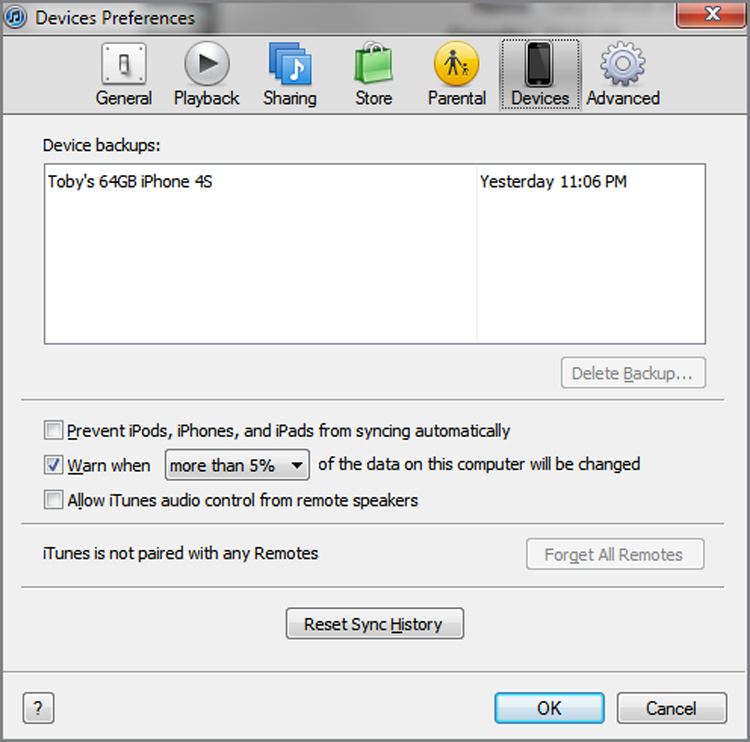
The selection of what is to be synchronized is a task unto itself, but with specific tabs for each class of data, iTunes allows you to make very granular choices about what you want to sync. The following list gives the basic characteristics of each tab:
- Info—contacts, calendars, mail, and bookmarks to be synced
- Apps—apps to be synced, their orientation on the different Home screens, and documents, if any, available through apps that support file sharing
- Tones—ringtones to be synced
- Music—music to be synced and playlist, artist, album, and genre sections for making selections in partial syncing
- Movies—movies and video clips to be synced
- TV Shows—TV shows to be synced
- Books—books to be synced
- Photos—photos to be synced
If the iOS device is running iOS version 5 or higher and the computer it syncs with is running iTunes version 10.5 or higher, you can sync your iOS device by using WiFi. Besides these minimum version requirements, a few things have to come together before this will work. The following list outlines these requirements.
- Apple states the iOS device must be plugged in to a source of power before sync will occur. It has been demonstrated that given enough battery power, the iOS device will sync without being plugged in.
- The iOS device should not be plugged into the USB port of the computer it syncs with. USB synchronization overrides WiFi synchronization.
- The iOS device and the computer it syncs with must be on the same WiFi network, which means the SSID of the WiFi network they are attached to is the same and you are sure the wireless network is not misconfigured to produce a false positive result, such as with two unconnected WAPs configured with the same SSID.
- The computer the iOS device syncs with must have iTunes running. Otherwise, the Sync Now button on the iOS device will be dimmed. When in this state, however, once iTunes is opened and all other requirements are met, WiFi sync will begin automatically if not disabled in Devices Preferences.
For syncing over WiFi to occur, it is not necessary to remove the wired connection of the computer running iTunes, if one exists. Although the computer will favor the use of the wired connection over the wireless link for regular network traffic, iTunes forces the communication to the iOS device to occur over the WiFi link during establishment of the connection and synchronization.
You can tell the difference between when a device is connected over WiFi versus when it is charging while connected by USB. Figure 18-23 shows a device after its WiFi synchronization has run. The eject icon changes to a rotating sync icon when sync is running.
Figure 18-23: An iOS device connected by WiFi
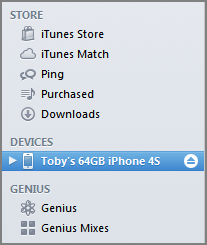
You can also see in Figure 18-24 that iTunes states in the Version section of the Summary tab that updating software on the iOS device or restoring from a backup must occur over a USB connection, implying that it cannot occur over WiFi. When connected by USB, regardless of whether the device is charging, this same section contains a Restore button and a Check For Update button.
Figure 18-25 shows the same device connected to the iTunes computer with a USB cable. Notice the battery charging indicator that was not there when there was only WiFi connectivity. While the device is connected by USB, the indicator will also disappear when the battery fully charges.
Figure 18-24: Apple iTunes requesting USB connectivity

Figure 18-25: An iOS device connected by USB
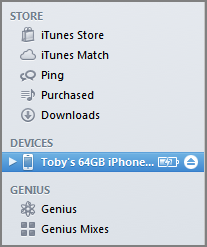
If automatic synchronization is disabled in Devices Preferences, manual synchronization of an iOS device can be started by clicking the iOS device in the left frame in iTunes and then clicking the Sync button at the bottom-right corner of its Summary tab. Alternatively, you can right-click the device in the left frame and choose Sync from that menu, as shown in Figure 18-26.
Figure 18-26: Manual synchronization in iTunes
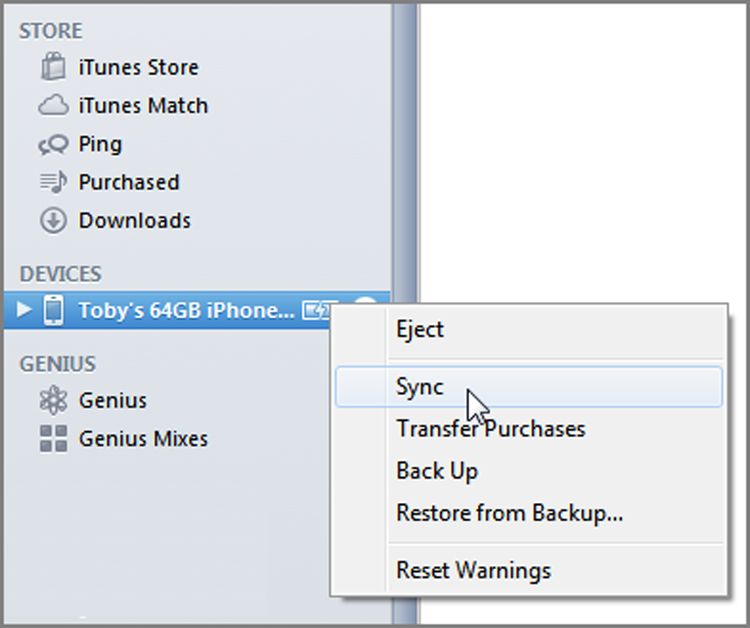
Regardless of whether you are connected to the iTunes computer over WiFi or by USB, you can also force a manual sync to begin by running the Settings app, selecting General, then selecting iTunes Wi-Fi Sync. Doing so takes you to the screen in Figure 18-27. In this example, there is an issue connecting to the last computer with which the iOS device synced. The Sync Now button is not selectable. This likely means that the device is attached by WiFi. As counterintuitive as it sounds, if a USB connection exists, the Sync Now button will be lit and can be used to start the wired synchronization.
As soon as the issue is resolved, a screen similar to the one in Figure 18-28 appears. Notice the selectable Sync Now button.
Figure 18-27: Disabled button in iTunes Wi-Fi Sync screen
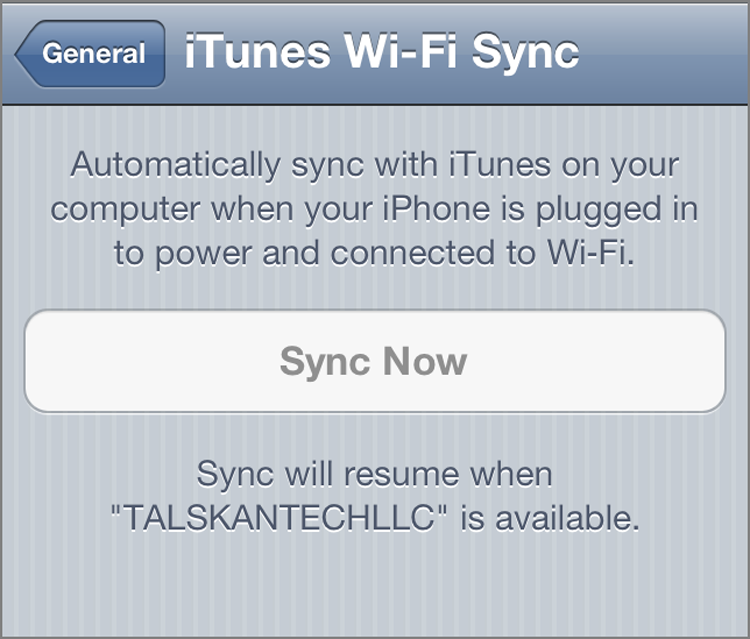
Figure 18-28: Enabled button in iTunes Wi-Fi Sync screen
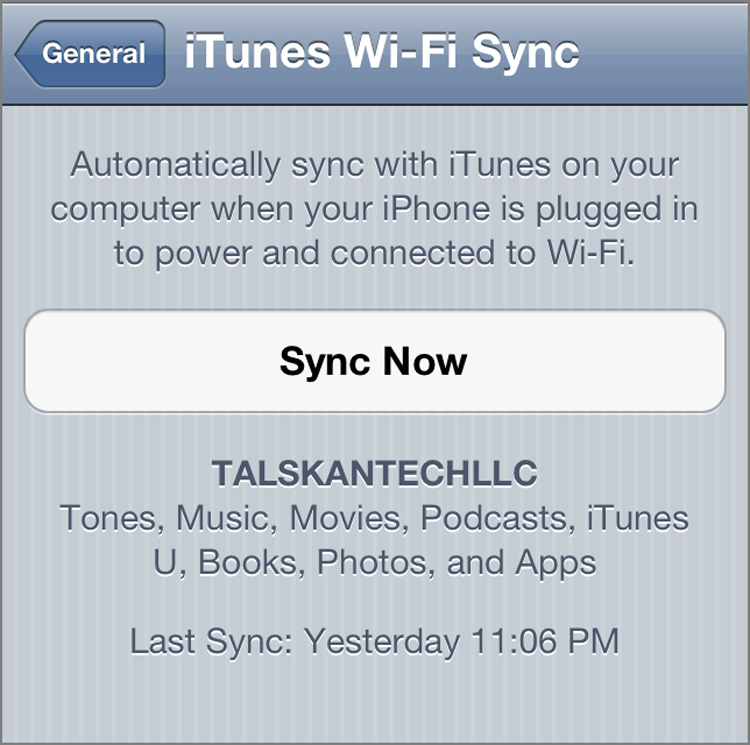
Tapping the Sync Now button eventually changes it to read Cancel Sync, as shown in Figure 18-29, and shows you the progress of the wireless or wired sync. The progress can also be followed from iTunes.
Figure 18-29: Cancel Sync button in iTunes Wi-Fi Sync screen
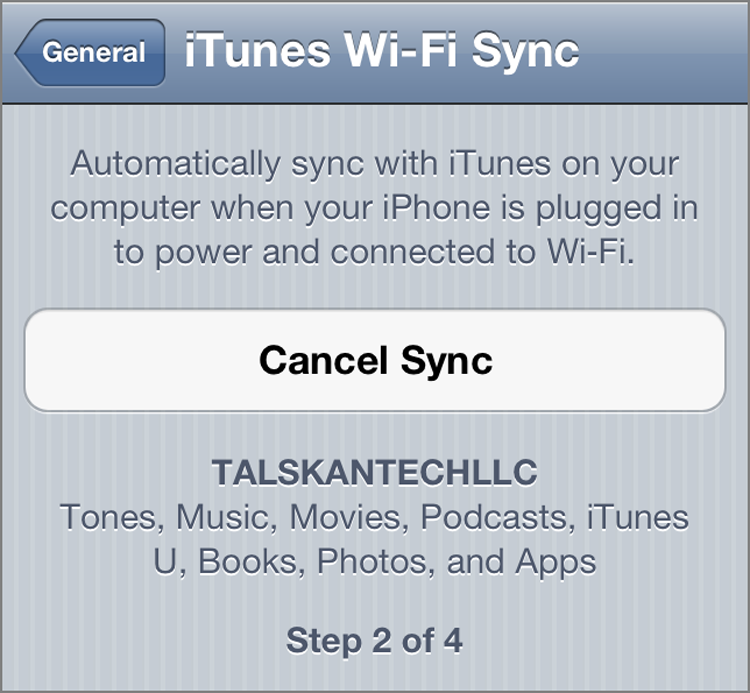
Syncing Android Devices
Just as with Apple’s devices, mobile devices built for the Android operating system can be synced to a traditional computer. Apple’s iTunes is proprietary and has been designated as the application that performs synchronization of iOS devices. In a similar way, manufacturers of Android devices have their own syncing utilities. Because this software and the connection methods allowed vary widely from one manufacturer to another, it is difficult to predict exactly what one manufacturer will offer in its utility and if each Android device it produces will interact the same way and over the same connections.
It should be assumed that, at a minimum, the same items that can be synced with iOS devices and iTunes can likely be synced for Android devices as well. What is also safe to assume is that no utility with the popularity and well-designed integration and features of iTunes exists for the Android market. Many manufacturers, however, create utilities that can tap into the playlists of iTunes and the data structures of Microsoft Outlook to obtain quite a bit of what they are looking for without the need to supply the same features in their own utilities. Don’t be surprised when you see an Android device with an exact replica of a computer’s iTunes playlists, names as well as contents.
Software Installation Requirements
As with any software, minimum hardware and disk-space requirements exist for installing the software that allows synchronization of mobile devices. Any computer that a user would install these software applications on should have USB and WiFi for connectivity. It never hurts to make sure, though. Here we’ll outline the minimum requirements for installing iTunes and HTC Sync, a utility for the devices made by the popular manufacturer HTC.
Installation Requirements for iTunes
Apple’s iTunes is available for Mac OS and Windows. The following sections list the hardware and software requirements for installing iTunes on each of these operating systems.
Windows Requirements
The following list details the minimum hardware requirements that a Windows machine must have to support the installation of iTunes version 10.6.1:
- 1GHz Intel or AMD processor
- 512MB of RAM
- To play standard definition video
- Intel Pentium D processor
- 512MB of RAM
- DirectX 9.0–compatible video card
- To play 720p HD video, an iTunes LP, or iTunes Extras
- 2.0GHz Intel Core 2 Duo processor
- 1GB of RAM
- Intel GMA X3000, ATI Radeon X1300, or NVIDIA GeForce 6150 video card
- To play 1080p HD video
- 2.4GHz Intel Core 2 Duo processor
- 2GB of RAM
- Intel GMA X4500HD; ATI Radeon HD 2400; NVIDIA GeForce 8300 GS video card
- Screen resolution of 1024×768 or greater; 1280×800 or greater to play an iTunes LP or iTunes Extras
- 16-bit sound card and speakers
- Broadband Internet connection
- iTunes-compatible CD or DVD recorder
Only certain versions of Windows support iTunes. The following list contains the software requirements for installing iTunes in Windows:
- Windows XP Service Pack 2; 32-bit editions of Windows Vista; 32-bit editions of Windows 7
- The iTunes 64-bit installer for 64-bit editions of Windows Vista or Windows 7
- 200MB of available disk space
Mac Requirements
Apple includes iTunes in its operating system and on each of its new machines. Nevertheless, Apple publishes minimum hardware and software requirements for the installation of iTunes 10.6.1 on a Macintosh. The following list includes hardware requirements:
- Mac computer with an Intel, PowerPC G5 or G4 processor
- 512MB of RAM
- To play standard definition video
- 1.0GHz PowerPC G4
- 512MB of RAM
- To play 720p HD video, an iTunes LP, or iTunes Extras
- 2.0GHz Intel Core 2 Duo processor
- 1GB of RAM
- To play 1080p HD video
- 2.4GHz Intel Core 2 Duo processor
- 2GB of RAM
- Screen resolution of 1024×768 or greater; 1280×800 or greater to play an iTunes LP or iTunes Extras
- Broadband Internet connection
- Apple combo drive or SuperDrive; possibly some non-Apple CD-RW recorders)
The Macintosh software requirements are shown in the following list:
- Mac OS X version 10.5.8
- Safari 4.0.3
- 200MB of available disk space
Installation Requirements for HTC Sync
A very popular manufacturer of mobile devices, HTC produces its own utilities for syncing its devices to your computer. Its ever-popular and widely supported HTC Sync application has been joined by HTC Sync Manager for a small subset of devices. In the past, HTC allowed syncing over Bluetooth, but today, syncing with HTC Sync requires a USB 2.0 connection.
The following list outlines the capabilities of HTC Sync. Note the similarity to general syncing interests as well as to those particular to iTunes:
- Synchronize Outlook contacts and calendar or Outlook Express contacts
- Synchronize web browser bookmarks
- Install third-party Android applications
- Bring the following items to your phone:
- Photos
- Videos
- Documents
- Songs
- Playlists
Because we are interested in establishing the basic functionality that allows synchronization to occur, let’s take a look at the system requirements for installing HTC Sync. You’ll notice they are in line with those for installing iTunes. HTC Sync is not supported for Mac at this time, so only Windows requirements are listed in this section.
This list specifies the minimum hardware requirements that a Windows machine must have to support the installation of HTC Sync version 3.2.10:
- Intel Pentium III processor
- 1GB of RAM
- XGA (1024×768) resolution video adapter and monitor
- 300MB of available free hard disk space
- USB 2.0
The software requirements in the following list are similar as well:
- Windows XP Home/Professional/Media Center Edition Service Pack 2 and 3 (x86)
- Windows Vista Ultimate/Enterprise/Business/Home Premium/Home Basic Edition (x86 or x64) Service Pack 1
- Windows 7 Ultimate/Professional/Home Premium/Home Basic Edition (x86 or x64)
- Microsoft Office Outlook 2000, XP, 2003, 2007 or 2010 (x86 or x64)
HTC reminds you to enable USB debugging to make sure HTC Sync works properly. This setting is for developers and for applications to gain a deeper access to the resources of the device. Most apps don’t require it, but some, such as HTC Sync, cannot function properly or consistently without it. To make sure USB debugging is enabled on your HTC Android device, select Settings > Applications > Development and check the box beside USB Debugging. You should disconnect and reconnect the device after making this change.
